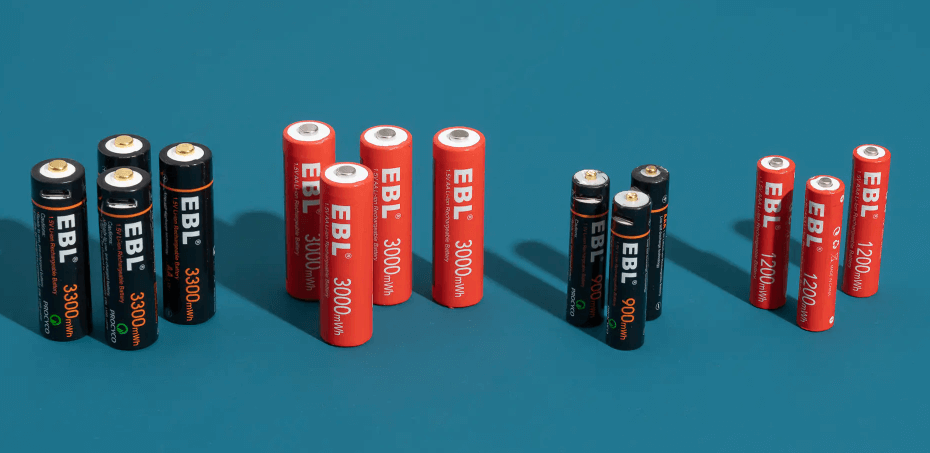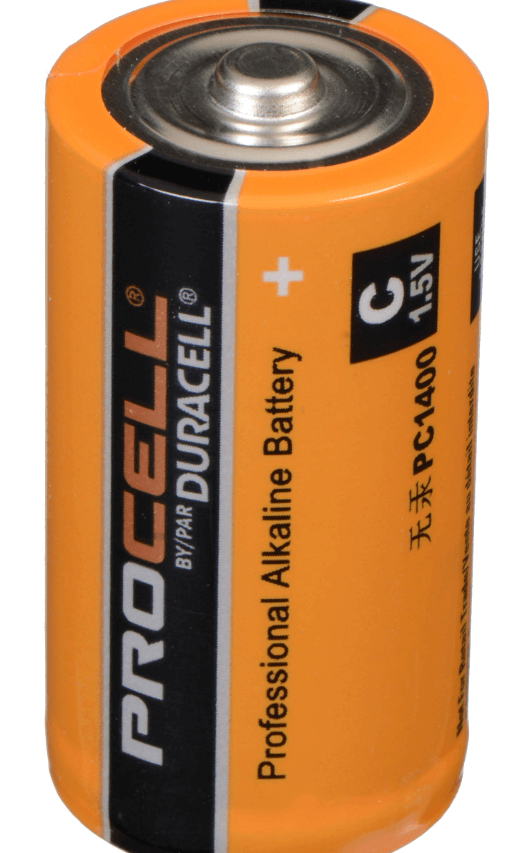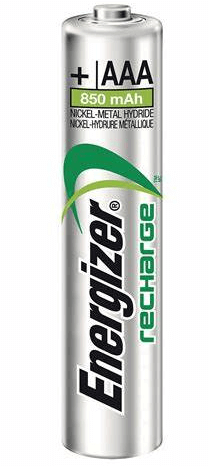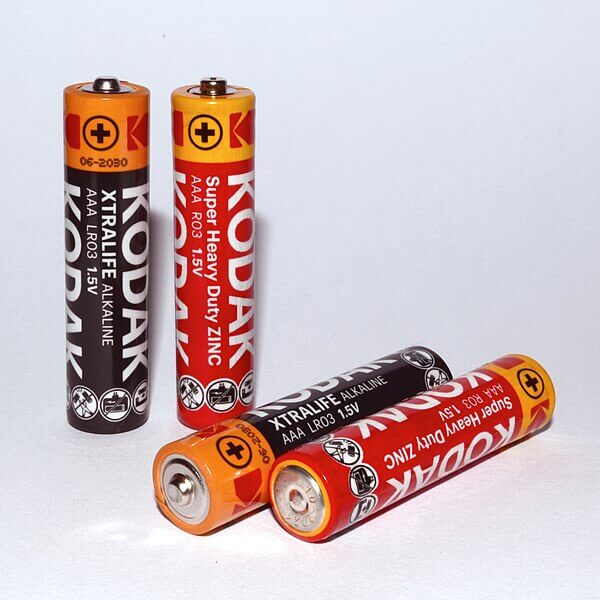HomeBlogAAA Batteries: Types, Voltage Characteristics, Maintenance
AAA Batteries: Types, Voltage Characteristics, Maintenance
AAA batteries, a ubiquitous component in small electronic devices, serve as a vital power source due to their compact cylindrical form and consistent performance. Measuring just 10.5 millimeters in diameter and 44.5 millimeters in length, these batteries fit neatly into a multitude of devices from household gadgets to high-tech equipment. Known internationally by various names such as LR03 and HR03, their most common designation, "AAA", unifies their identity across global markets, ensuring ease of recognition and compatibility. This article delves deeply into the specifics of AAA batteries, exploring the different types available, their chemical makeup, performance characteristics, practical applications, and best practices for maintenance and installation to optimize their longevity and reliability.
Catalog
Figure 1: AAA Batteries
AAA batteries, commonly used in a variety of small electronic devices, are cylindrical. They measure approximately 10.5 millimeters (0.41 inches) in diameter and 44.5 millimeters (1.75 inches) in length. These batteries are known under different names globally, such as LR03, R03, FR03, and HR03, depending on their chemical composition and the standards required by different countries and regions. Despite the variety in labeling, major brands consistently use the "AAA" designation, ensuring widespread recognition and universal applicability. This naming consistency helps users and technicians accurately identify and utilize these batteries across various applications.
AAA batteries are divided into two types: non-rechargeable and rechargeable, each based on a specific chemical composition that affects its voltage, capacity, and discharge rate. Here’s a detailed look at these batteries and their practical applications:
Non-rechargeable batteries
This type of battery is typically used in portable devices with low current requirements. They include zinc carbon batteries and alkaline batteries.
Figure 2: Zinc-carbon batteries
Zinc-carbon battery: As a traditional dry battery, a zinc-carbon battery generates 1.5 volts through the electrochemical reaction of zinc and manganese dioxide. Zinc typically forms the cylindrical casing of the battery, while a central carbon rod surrounds the manganese dioxide cathode. Although they are affordable, they can drain power quickly in high-power environments.
Figure 3: Lithium Batteries
Lithium Batteries: One of the standout features of lithium metal batteries is their exceptionally low self-discharge rate. This quality allows them to maintain their charge for extended periods, with a shelf life that can reach up to 10 years under optimal storage conditions. Lithium metal batteries utilize an iron disulfide cathode, which provides a stable nominal voltage of 1.5 volts. This combination of low self-discharge rate, high voltage stability, and extended shelf life makes lithium metal batteries an excellent choice for consumers and industries looking for reliable, long-term energy solutions.
Figure 4: Alkaline Battery
Alkaline batteries: This type of battery uses potassium hydroxide as the alkaline electrolyte to provide energy through the reaction of zinc and manganese dioxide. Since their introduction to the market in 1959, alkaline batteries have gradually replaced zinc-carbon batteries due to their more stable voltage output and longer service life.
|
Zinc-carbon AAA Battery
Nominal Voltage
|
1.50 Volts
|
|
AAA Battery Capacity
(Avg.)- Alkaline
|
≈600mAh
|
|
Operating
Temperature
|
0°C – 60°C
|
|
Diameter
|
14.5mm
|
|
Height
|
50.5mm
|
|
Chemistry
|
Carbon Zinc
|
Chart
1: Technical Specifications of Zinc-carbon AAA Battery
|
Lithium AAA Battery
Nominal Voltage
|
1.50 Volts
|
|
AAA Battery Capacity
(Avg.)- Alkaline
|
≈600mAh
|
|
Operating
Temperature
|
0°C – 60°C
|
|
Diameter
|
14.5mm
|
|
Height
|
50.5mm
|
|
Chemistry
|
Lithium
|
Chart
2: Technical Specifications of Lithium AAA Battery
|
Alkaline AAA Battery
Nominal Voltage
|
1.50 Volts
|
|
AAA Battery Capacity
(Avg.)- Alkaline
|
≈ 1200 mAh
|
|
Operating
Temperature
|
0°C – 60°C
|
|
Diameter
|
14.5mm
|
|
Height
|
50.5mm
|
|
Chemistry
|
Alkaline
|
Chart
3: Technical Specifications of Alkaline AAA Battery
Rechargeable battery
Suitable for high power consumption devices as they can be recharged and used repeatedly.
Nickel-metal hydride battery (NiMH): The positive electrode of this battery is composed of nickel hydroxide, and the negative electrode is a hydrogen-absorbing alloy. Since their commercial introduction in 1989, they have been widely used in portable electronic devices and electric vehicles. NiMH batteries offer high energy density and long cycle life and are less susceptible to memory effects.
Figure 5: Nickel-metal Hydride Battery
Nickel-cadmium battery (NiCd): A battery with nickel hydroxide and metallic cadmium as electrodes. This kind of battery is characterized by low internal resistance, can provide high power output, and is suitable for applications that require fast charging and discharging. Nonetheless, they have relatively low energy storage capacity and may suffer from memory effect issues.
Figure 6: Nickel-cadmium Battery
High voltage lithium batteries: Includes lithium metal and other lithium-based batteries, such as lithium iron sulfide batteries. With nominal voltages up to 1.5 volts, these batteries are distinguished by their extremely low self-discharge rate and can be stored at extreme temperatures for up to 10 years.
|
Chemistry
|
Common Name
|
Rechargeable
|
Typical Capacity (mAh)
|
Voltage
|
|
Zinc
Carbon
|
R03,
24D
|
No
|
500-600
|
1.5
|
|
Alkaline
|
LR03,
24A
|
Mostly
No
|
850-1200
|
1.5
|
|
Li-FeS2
|
FR03,
24LF
|
No
|
1100-1300
|
1.5
(1.8 max)
|
|
Li-ion
|
10440
|
Yes
|
350-600
|
3.6 -
3.7
|
|
LiFePO4
|
IFR10440,
IFR10450
|
Yes
|
250-300
|
3.2
|
|
Li-SOCl2
|
(10450)
|
No
|
600-800
|
3.6-3.7
|
|
Lithium
|
-
|
Yes
|
400-600
|
1.5
|
|
NiCd
|
KR03,
24K
|
Yes
|
300-500
|
1.2
|
|
NiMH
|
HR03,
24H
|
Yes
|
600-1300
|
1.2
|
|
NiOOH
|
ZR03
|
No
|
1000-1200
|
1.5
(1.7 max)
|
|
NiZn
|
-
|
Yes
|
500-700
|
1.6 -
1.65
|
Chart
4: Characteristics of AAA Batteries
The voltage characteristics of a AAA battery demonstrate the relationship between the battery type and its chemical composition. Different types of AAA batteries have different voltage characteristics based on their chemical composition.
Zinc-carbon batteries typically start at 1.5V, but their voltage drops rapidly over time. This means that after a period of use, the battery's output voltage may not be sufficient to support the normal operation of some devices.
Compared with zinc-carbon batteries, alkaline batteries also have a starting voltage of 1.5V, but they perform better in terms of voltage stability. This allows alkaline batteries to maintain a more stable voltage output after long-term use.
The open circuit voltage of a lithium iron disulfide (Li-FeS2) battery can reach 1.8V without load. However, once a slight load is applied, the voltage drops to 1.5V, which is a voltage change to be aware of, especially during the early stages of battery life.
Nickel metal hydride (NiMH) and nickel-cadmium (NiCd) batteries generally offer lower voltages, around 1.2V. This lower voltage nature means they may not be suitable for devices requiring 1.5V.
Lithium iron phosphate (LiFePO4) and lithium-ion batteries offer higher voltages, typically between 3.2V and 3.7V. The high voltage output of these batteries makes them ideal for high-end devices that require higher voltages.
When choosing an alternative to AAA batteries, users need to choose the appropriate battery based on the voltage needs of their device. Most conventional devices require around 1.5V to operate properly. Therefore, it is necessary to understand the voltage output of different battery types in advance to choose the most suitable battery.
Figure 7: AAA Batteries
Non-rechargeable AAA batteries mainly include zinc-carbon batteries and alkaline batteries, which are the most common battery options on the market.
Zinc-carbon batteries are a more economical option, with the advantage of low initial cost. However, their main disadvantages are smaller battery capacity and less stable voltage, which makes them poor performers on devices that require long or stable power supplies. When using this battery, users may notice a noticeable drop in device performance after half of the battery is drained, especially on devices with higher power requirements.
In contrast, alkaline batteries are favored for their high energy density and more stable voltage output. Not only do these batteries offer longer life, but they also have a longer shelf life, making them the first choice for disposable batteries. Alkaline batteries can maintain voltage stability while continuously outputting higher currents, which makes them perform better in devices with high-performance requirements.
Although usually designed for single use, some specialty alkaline AAA batteries can be recharged multiple times, although this is not their standard use. This special design increases the flexibility of the battery and provides users with more choices. For example, these batteries can be recharged for extended use in emergencies or when new battery replacements are temporarily unavailable, although the charging efficiency and battery life may not be as high as that of specially designed rechargeable batteries.
Figure 8: Non-rechargeable Battery
Rechargeable AAA batteries, specifically NiMH and various types of Li-ion batteries, bring users long-lasting and cost-effective energy options. The development and widespread use of these batteries is reflected in how they meet the continuous operation needs of modern equipment.
Take the Panasonic Eneloop series, for example. These batteries are prized for their large battery capacity and extremely low self-discharge characteristics. Eneloop batteries lose
almost no power when not in use, making them ideal for devices that may not be used for long periods but may need a quick start at any time. Users will experience significant convenience when using these batteries, as they reduce the need for frequent charging and provide a more reliable energy supply.
The environmentally friendly properties of rechargeable AAA batteries are also an important factor in their popularity in the market. With the global awareness of sustainable development and environmental protection increasing, these batteries support recycling and reduce the emission of waste and harmful substances. They are also becoming increasingly common in electric vehicles and portable electronic devices, with electric vehicles particularly relying on high-efficiency, long-life battery technology to maintain their performance and efficiency.
With the continuous advancement of technology, the performance of rechargeable AAA batteries continues to improve. These batteries can now not only provide a long-term energy supply but also charge quickly, meeting the fast pace of modern life. For example, newer generations of fast-charging batteries can be fully charged in a few hours, while older batteries may need to be charged overnight. This allows users to consider not only their durability when choosing a battery but also theirs charging speed and overall convenience.
Figure 9: Rechargeable Battery
The service life of AAA batteries is strongly affected by differences in their chemical composition and storage environment. By following some basic care guidelines, users can significantly improve battery efficiency and extend its life.
First of all, a good storage environment is the first step to maintaining the health of the battery. For example, alkaline batteries can maintain performance for more than 10 years in a dry, cool environment. Under such conditions, batteries are less susceptible to damage from heat or humidity, factors that typically speed up chemical reactions that cause the battery to lose power.
For high-performance lithium iron disulfide batteries, proper storage conditions can even extend the battery life to more than 20 years. This type of battery is designed to be more durable and adaptable to storage conditions, so it performs better in long-term storage.
Understanding and following these maintenance and storage tips can greatly improve battery performance and extend battery life. In addition to this measure, avoiding exposure of the battery to extreme temperature conditions is another important measure to keep the battery healthy. Excessive heat or cold can cause irreversible damage to the battery's chemical makeup, shortening its life.
By choosing the right storage environment and careful maintenance, the service life of AAA batteries can be significantly extended. These simple steps not only help maintain battery performance but also reduce environmental pollution and achieve financial savings.
Because of their compact size and stable power output, AAA batteries have become the energy source of choice for a variety of small devices, including digital thermometers, laser pointers, flashlights, and other common tools. When using these batteries, proper installation is a fundamental step in ensuring proper operation of the device.
First, we need to identify the positive and negative poles of the battery. AAA batteries are usually marked with a plus sign (+) on one end and a minus sign (-) on the other. When installing the battery, you need to carefully check the logo in the battery compartment of the device to ensure that the positive pole of the battery corresponds to the positive pole mark in the device, and the negative pole corresponds to the negative pole mark. If the battery is installed backward, the device may not work or may even damage the device's circuitry.
Secondly, when installing the battery, gently place the battery into the device. Avoid using excessive force as this may bend or damage the metal contacts inside the device. These metal pieces are very important as they ensure the electrical connection between the battery and the device. If the contact piece is damaged, it may cause an unstable power supply to the equipment and affect the performance of the equipment.
Finally, make sure the battery compartment lid is closed properly. This helps protect the battery and internal connections from dust and moisture. It is also necessary to keep the battery compartment clean and inspect it regularly for the accumulation of corrosion or other contaminants.
Correctly installing the battery and maintaining the battery compartment of the device are key measures to ensure the stable operation of the device and extend its service life. By following these simple steps, you can maximize the effectiveness of your AAA batteries while ensuring the best performance of your device.
As we wrap up our in-depth exploration of AAA batteries, it’s clear that understanding the specifics of the battery type, its operating parameters, and proper maintenance is beneficial to maximizing performance. Whether it's choosing the right battery for specific devices or ensuring proper storage conditions, each step plays a significant role in enhancing performance and extending battery life. For consumers and professionals alike, adhering to these guidelines ensures not only the efficient operation of their devices but also contributes to sustainability by minimizing waste and reducing the environmental impact of used batteries. As technology advances, the role of AAA batteries in powering our portable devices remains indispensable, making our grasp of their characteristics and care increasingly important.
Frequently Asked Questions [FAQ]
1. What is the AAA battery type?
A AAA battery is a standard size of dry cell battery, typically used in portable electronic devices. The AAA designation refers to the size and shape of the battery, which is smaller and narrower compared to AA batteries.
2. Why is it called AAA battery?
The "AAA" designation refers to the size and classification according to standards set by the American National Standards Institute (ANSI). The naming convention is based on the physical size of the battery, with AAA being one of the smallest in standard battery sizes.
3. What AAA means?
AAA generally stands for "Triple A" about the size and classification of the battery.
4. What does AAA stand for on a battery?
On a battery, "AAA" stands for the size category of the battery.
5. How do you tell if a AAA battery is good or bad?
To determine whether a AAA battery is good or bad, you can use a few methods:
Voltage Test: A fully charged AAA battery should typically show a voltage of about 1.5 volts for alkaline and 1.2 volts for rechargeable NiMH batteries. If the voltage is significantly lower, the battery may be bad or discharged.
Physical Inspection: Check for any signs of corrosion, leakage, or swelling. These are indicators that the battery is no longer good and should be replaced.
Performance Test: Place the battery in a device and see if it powers the device effectively. If the device doesn’t work or performs poorly, and you know the device is in good working order, the battery may be depleted or damaged.








